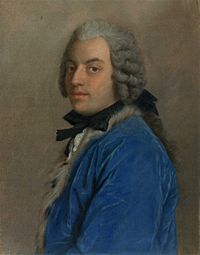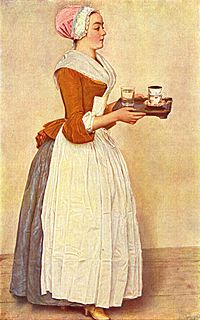Francesco Algarotti facts for kids
Quick facts for kids
Francesco Algarotti
|
|
|---|---|

Portrait by Jean-Étienne Liotard (1745), Rijksmuseum, on parchment
|
|
| Born | 11 December 1712 |
| Died | 3 May 1764 (aged 51) |
| Nationality | Venetian |
| Occupation | Philosopher |
Count Francesco Algarotti (born December 11, 1712 – died May 3, 1764) was a very talented person from Venice. He was known as a polymath, which means he had knowledge in many different areas. He was a philosopher, poet, writer, and even an art critic and collector.
Algarotti was an expert in many fields, including Newtonianism (the ideas of Isaac Newton), architecture, and opera. He was good friends with important people like Frederick the Great and famous writers such as Voltaire. Many other important figures, like Lord Chesterfield and Pope Benedict XIV, also wrote letters to him.
Contents
Early Life and Learning
Francesco Algarotti was born in Venice. His family was wealthy, and his father and uncle collected art. Unlike his older brother, Francesco chose to become a writer instead of joining the family business.
He studied natural sciences and mathematics in Rome and Bologna. In 1728, he even experimented with optics, which is the study of light. One of his teachers, Francesco Maria Zanotti, became a lifelong friend.
Algarotti was very curious and loved to travel. He first visited Paris when he was in his early twenties. There, his charm, interesting conversations, and intelligence impressed thinkers like Pierre-Louis Moreau de Maupertuis and Voltaire. Two years later, he was in London and became a member of the Royal Society, a famous group for scientists.
He later returned to Italy and finished his book, Neutonianismo per le dame ("Newtonism for Ladies"). This book, published in 1737, explained astronomy, physics, and mathematics in a way that was easy to understand. It also discussed women and education.
Travels and Career
Algarotti met Antiochus Kantemir, a diplomat and poet from Moldavia. He was invited to visit Russia for a royal wedding. In 1739, he traveled from England towards Russia. On his way back from Saint Petersburg, he visited Frederick the Great in Germany.
Frederick was very impressed by Algarotti's vast knowledge. In 1740, Frederick made Francesco and his brother Bonomo counts of Prussia. Algarotti traveled with Frederick to several places, including Königsberg, where Frederick was crowned king.
Algarotti also met Voltaire again during these travels. In 1741, Algarotti became a diplomat for Frederick in Turin. Frederick offered him a salary, but Algarotti did not accept it. He traveled to Dresden and Venice, where he bought 21 paintings for the court of Augustus III of Poland. These paintings included works by Jean-Étienne Liotard and Giovanni Battista Tiepolo.
Algarotti and the Arts

Algarotti loved art and collected many different types of works. His collection showed his interest in the Neoclassic era, which focused on classical styles. He wanted to create a modern museum that showed different art styles from various time periods.
He even made a list of paintings he wanted artists to create for him. This included historical scenes from artists like Tiepolo and Giambattista Pittoni. He also wanted animal scenes from Castiglione and views of ruins from Pannini. He supported many other artists, too.
In 1747, Algarotti returned to Potsdam and became a court chamberlain. He later visited the ancient ruins at Herculaneum. In 1749, he moved to Berlin. Algarotti helped finish the architectural designs of Georg Wenzeslaus von Knobelsdorff, who was ill.
In 1753, after living in Prussia for several years, he moved back to Italy, mostly living in Bologna. In 1759, Algarotti helped create a new style of opera in the city of Parma. He influenced important people like Guillaume du Tillot and the Duke of Parma.

Algarotti's book, Essay on the Opera (1755), had a big impact on how operas were made. He believed that the story and drama in an opera should be the most important part, not just the music or dancing. He thought opera should "delight the eyes and ears" and "affect the hearts" of the audience, while still making sense. His ideas influenced famous composers like Gluck.
In 1762, Algarotti moved to Pisa, where he sadly died from tuberculosis. Frederick the Great, who often asked Algarotti to write texts in Latin, sent a text for a monument to honor him at the Campo Santo in Pisa.
Works
- "Saggio sopra la pittura" (An essay on painting)
- "An essay on architecture" (1753)
- "Letters military and political" (1782)
- "Essai sur la durée des règnes des sept rois de Rome" (An essay on the length of the reigns of the seven kings of Rome)
- "Essai sur l'empire des Incas" (An essay on the Inca Empire)
Gallery
-
Algarotti was involved in the design of the Französische Kirche in Potsdam; picture taken just after the war.
Images for kids
See also
 In Spanish: Francesco Algarotti para niños
In Spanish: Francesco Algarotti para niños








